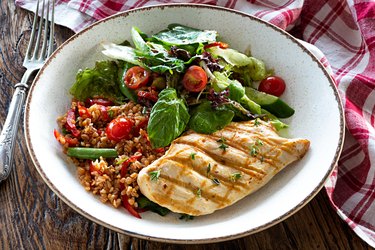
Whether it's your tax return or weight-loss goal, good things come to those who wait. While you may be eager to shed some unwanted pounds, patience and consistency are your two greatest assets when it comes to losing weight.
You can definitely make some excellent progress in just two weeks but there's only so much weight you can lose in a short amount of time. Instead, use this time to set up healthy habits and sustainable, long-term goals. Here are three tactics to get you started.
Video of the Day
Video of the Day
1. Create a Safe Calorie Deficit
While you probably won't be able to slim down too significantly in just two weeks, it's plenty of time to set up a healthy weight-loss routine. Creating a safe and sustainable calorie deficit is the primary component behind any weight-loss goal. A calorie deficit is when your body burns more calories than it consumes, according to the Mayo Clinic.
To set up a good calorie deficit for your body, you need to establish how many calories you're eating to sustain your current weight (your maintenance calories). Your maintenance caloric level is affected by numerous factors, including age, sex and activity level.
To find your maintenance calories, track your food and calories using an app or food diary for a few days. Assuming you don't gain or lose any weight during that time, you'll be able to find how many calories you eat each day to sustain your weight.
Then, from there, you can safely cut between 500 to 1,000 calories each day to create your deficit, according to the Mayo Clinic. Considering there's about 3,500 calories in one pound of fat, this rate will help you lose about 1 to 2 pounds per week.
The more calories you cut, the faster you will lose weight. But while you may feel inclined to cut a bunch of calories quickly, keep in mind that a slower weight-loss-rate will help you keep the weight off in the long run and build lifelong healthy habits, according to the Mayo Clinic.
Related Reading
2. Follow a Healthy Weight-Loss Plan
Ideally, your calorie deficit shouldn't leave you starving and hungry for junk food (otherwise it wouldn't be sustainable). But nevertheless, getting out of your usual eating routine can be tricky. Consider these three tips to make your calorie deficit easier to follow.
Eat Plenty of Veggies
Fill your plate with whole veggies and leafy greens. Whether you're eating leafy greens or large, whole vegetables, plants are generally low in calories and high in fiber. These foods can add volume to your meal, helping you feel full on less food.
Related Reading
Prioritize Whole Foods
Swap processed foods (like cookies or chips) for low-calorie, nutrient-dense whole foods, per the Mayo Clinic.
Choosing sparkling water instead of soda, a baked sweet potato instead of fries or oats instead of cereal will cut back on your calories. Plus, these healthier options will also help you get all the nutrients you need.
Don't Skimp on Protein
As you're planning your meals, make sure to add protein. Protein can be an easy food to cut, as carbs and fats are usually tastier. But folks who are trying to lose weight should actually eat more protein than usual, according to a December 2019 meta-analysis published in Advances in Nutrition.
Protein boosts satiety and will help you preserve your muscle mass during your weight-loss journey. Opt for leaner protein sources — such as chicken, fish and low-fat dairy — which will give you more food for less total calories.
3. Create an Enjoyable Exercise Routine
While your diet is the primary component to weight loss, creating a fun exercise routine will help you burn extra calories and improve your overall health and body composition (your body's ratio of muscle to fat). Here are some recommended ways to get more physical activity.
Cardio
At the least, shoot to get 150 minutes of moderate cardio activity (like walking) each week, recommend the Centers for Disease Control and Prevention (CDC). That shakes out to around 20 minutes a day.
If you're not a fan of steady-state cardio exercise, you can try and get at least 75 minutes of vigorous cardio each week. High-intensity interval training (HIIT) is a great exercise option for those that love to be in and out of the gym as quickly as possible. HIIT will spike your heart rate and help boost your metabolism.
Related Reading
Strength Training
Incorporating about two days of strength training each week can also help with weight loss. Lifting weights can help increase your muscle mass, which can speed up your metabolism, according to Harvard Health Publishing.
While a healthy eating plan paired with a regular exercise routine can help you shed any unwanted weight, consistency should be your number one priority. You may be eager to lose weight ASAP but creating a sustainable, long-term plan will give you the results you want in the weeks, months and years to come.
Related Reading
- Mayo Clinic: "Counting Calories: Get Back to Weight-Loss Basics"
- Mayo Clinic: "Why do Doctors Recommend a Slow Rate of Weight Loss? What's Wrong With Fast Weight Loss?"
- Advances in Nutrition: "Protein Intake Greater than the RDA Differentially Influences Whole-Body Lean Mass Responses to Purposeful Catabolic and Anabolic Stressors: A Systematic Review and Meta-analysis"
- Harvard Health Publishing: "The Truth About Metabolism"
- Centers for Disease Control and Prevention: "Physical Activity Guidelines for Americans"
Was this article helpful?
150 Characters Max
0/150
Thank you for sharing!
Thank you for your feedback!